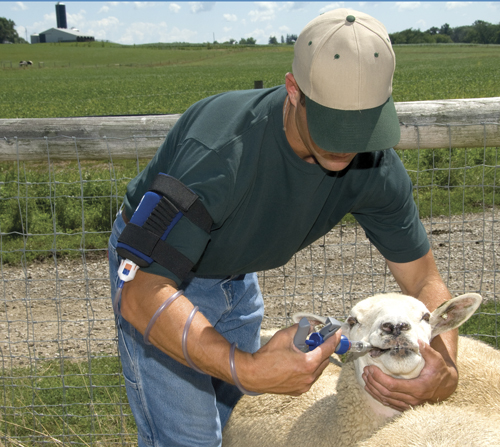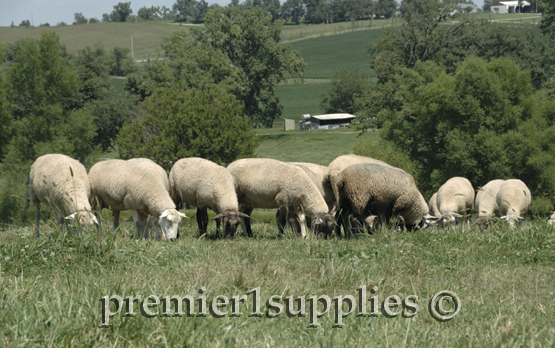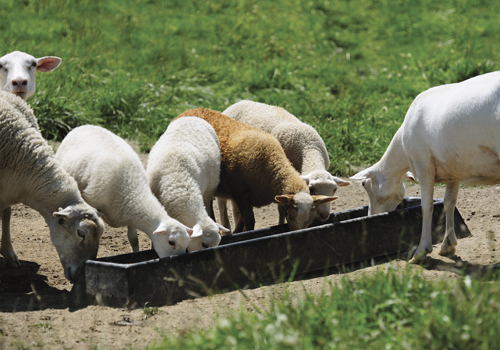Looking back on it, it all seems pretty obvious now. Of course the problem in my flock was Ovine Progressive Pneumonia (OPP). I have had sheep with just about all the symptoms, but it took me a few years to notice it and a few more to figure out how to deal with it.OPP is a classic flock health problem that can destroy profitability by making each sheep just a little less productive. In my flock, it first manifested itself with a few poor-doers who had little or no milk at lambing time. These ewes were culled. Then I started to notice weaning weights going down and ewes were having a hard time recovering body condition after weaning. This started to suppress reproductive efficiency, so not only was I weaning lighter lambs, but I was also weaning fewer of them.
I bring all my lambs to finish and market them as either whole carcasses or cuts, so I was also keenly aware that my low weaning weights were correlated with longer times on feed post-weaning to reach acceptable carcass weights. Where I used to be able to finish my May-born lambs on stockpiled pasture in November and early December, I was now having to buy hay and feed them into January, February and sometimes even March.
My first guess was that there was a nutrition problem. My flock grazes some fairly poor pasture, and I figured that the answer was to supplement their diets with concentrate. I started feeding a little bit of whole corn in late gestation, continued it through lactation, and gradually brought the lambs up to 1 pound each per head per day plus our best managed pasture after weaning.
The ewes did recover their body condition quicker, but there was no real improvement in weaning weights. I was able to cut a little bit of time off the length of lamb feeding post weaning, but it came at a very high cost.
Grains are very expensive in New England. For each lamb I marketed I was spending nearly $25 on corn, which was an added cost of about 55 cents per pound on the carcasses. The fact that my lambs were no longer grass fed also cost me several customers.
I also checked for parasite problems. Like every pasture-based sheep flock in New England, I live with parasites and do my best to keep them from being a drag on production. Before-and-after fecal egg counts confirmed that the dewormers I was using were effective. Coccidiosis was a problem one summer, but not consistently.

Combating parasites (internal and external) can seem like a never ending job. Take fecal samples to determine what parasites you are fighting and to make sure the best product is being used.
My next strategy was to cull hard, bringing the flock down to just the ewes that could produce given the resources I could afford. I set a hard and fast rule: no ewe could stay in the flock unless she weaned at least 120 pounds of live lamb for multiples and 80 pounds for singles. I spent two years doing this, and my ewe flock dropped from 125 to 60. I figured I would rebuild from this core. When I studied who had stayed, I noticed that suddenly my oldest ewe was just five years old, whereas in the past I had had ewes that were productive to ages of seven, eight and even 10.
I also resolved to keep putting pressure on weaning weight as a selection criteria, because it was the heavier lambs at weaning time that were ready to go to slaughter the earliest and gained the best post weaning. But it quickly became apparent that I couldn’t retain enough ewe lambs to grow the flock if I was going to keep just the ewe lambs out of the top 25 percent of the flock. The numbers kept falling. I faced a decision: would I rather keep trying to cull my way back to a smaller but productive flock, or just try to manage my way out of it.
Then one day when I was moving the sheep over a woods trail to a neighboring farm, one of the ewes was straggling. She was a little winded, but there was something else. Her right rear leg clicked every time she took a step…arthritis in a four-year-old ewe? Then the penny dropped: low milk production, shortened productive lifespan, and arthritis in young sheep. The only OPP symptom I didn’t have in the flock was chronic lung problems.
After consulting with my vet, we decided to take a few random blood tests to see if my guess was right. I had the vet out for three blood draws. One was from the ewe with arthritis, the others were from seemingly healthy ewes who had met my standards for retention. All three were positive for OPP.

Though these animals appear healthy and in good condition, they could be harboring OPP. If production rates are lower than they should be, consult your veterinarian.
I got in touch with the OPP Concerned Sheep Breeders’ Society http://www.oppsociety.org/ and reviewed my options. In my particular situation, I decided the best option was to destock entirely and start over again. I could have tested every sheep, but with the symptoms so widespread in the flock it seemed I’d be better off to save the money the testing protocol would have cost and invest it in new stock. So, this winter, for the first time since 1990, there will come a point when I don’t have a single sheep to tend.
This was a very hard decision for me to come to, and I limited by options by the fact that it took me years to realize what was causing the production problems I was seeing. If I had suspected OPP earlier, I would have been able to address the flock health issues before years of declining profitability drained the resources I needed just to handle the work involved with the testing and culling that would have allowed me to clear the flock early on. I also might have been dealing with an infection rate that was low enough to be able to rid the flock of the disease without getting rid of all the sheep.
One of the main reasons I didn’t consider OPP as a potential culprit early on was that I had been taught the main way OPP moves through a flock is from dam to lamb via the milk, a process known as vertical transmission. The problems I was seeing early on – lack of milk at lambing time and general low productivity – were not associated with family lines. The ewes with problems were not related.
I’ve since learned that OPP also moves quite readily from adult to adult, a process known as horizontal transmission. The OPP Society’s website is a wonderful repository of information on how to identify OPP in your flock, and how to deal with it if it’s there. Learn from my example and educate yourself to early warning signs of OPP in your flock, and deal with it while you still have choices other than destocking.



